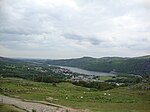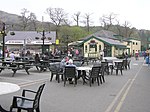1993 Llyn Padarn helicopter crash
1993 disasters in the United Kingdom1993 in WalesAccidents and incidents involving helicoptersAugust 1993 events in the United KingdomAviation accidents and incidents in 1993 ... and 2 more
Aviation accidents and incidents in WalesUse British English from June 2017

The 1993 Llyn Padarn helicopter crash occurred on 12 August 1993, when an RAF Westland Wessex helicopter, serial number XR524, with 3 crew and 4 passengers (all of them Air Training Corps cadets) on board suffered a catastrophic tail rotor failure and plunged into Llyn Padarn, a lake in North Wales. Three passengers were killed.
Excerpt from the Wikipedia article 1993 Llyn Padarn helicopter crash (License: CC BY-SA 3.0, Authors, Images).1993 Llyn Padarn helicopter crash
A4086,
Geographical coordinates (GPS) Address Nearby Places Show on map
Geographical coordinates (GPS)
| Latitude | Longitude |
|---|---|
| N 53.125277777778 ° | E -4.1294444444444 ° |
Address
A4086
LL55 4EY , Llanberis
Wales, United Kingdom
Open on Google Maps









